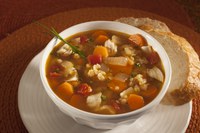Prairie Fare: Do You Include Pulse Foods on Your Menu?
(Click an image below to view a high-resolution image that can be downloaded)
By Julie Garden-Robinson, Food and Nutrition Specialist
NDSU Extension
“Mom, I made lentil soup and it’s pretty good,” read the text message from my son.
I smiled as I read the message from my formerly finicky 23-year-old son.
“I made a ton by accident, though,” he added.
I chuckled as I visualized my tall son stirring a giant pot of soup with a huge spoon. Then I remembered he doesn’t own an enormous soup kettle.
“Freeze it,” I texted back.
“I saved out enough for a few days and froze the rest,” he texted.
I count this conversation as a “parental victory.” Maybe he learned a little from us along the way because he’s cooking for himself and storing food safely.
Seeing your kids grow up and take on adult tasks, such as successfully cooking meals for themselves, makes parents proud. I especially liked the fact that he was preparing something healthful and budget-friendly.
Lentils and other pulse foods such as chickpeas and split peas are “local foods” because we grow them in abundance in North Dakota and neighboring states.
Pulse foods are the seeds of legumes. They are high in protein, and they also provide complex carbohydrates, vitamins such as folate, and minerals including potassium. They are especially high in fiber, with nearly 8 grams per half cup.
The unique nutritional profile makes pulses heart-healthy ingredients to add to your menu. If you enjoy hummus, you are enjoying chickpeas.
If you have a full cup of cooked lentils, you are about halfway to the daily fiber recommendations.
However, increase your dietary fiber gradually. Any time you increase the fiber in your diet, you need to drink plenty of water to avoid constipation.
Unlike chickpeas (also known as garbanzo beans), lentils do not require a soaking stage. To prepare lentils, simply remove any small stones, then place the lentils in a strainer and rinse with water. For every cup of lentils, add 2.5 cups of unsalted water. Heat the water to boiling, then simmer lentils for 15 to 20 minutes. One cup of dry lentils plus 2.5 cups of water equals about 2.5 cups of cooked lentils.
Pulse foods can play a prominent role in special diets. For example, those who must avoid gluten for medical reasons can enjoy pulses because they contain no gluten naturally. Gluten is a protein found in wheat, rye and barley.
Those with diabetes may find that eating pulses helps with blood glucose management. In fact, some studies have shown that consuming pulses may result in more stable blood glucose levels.
Pulses often play a prominent role in vegetarian diets because these plant foods are high in protein, vitamins and minerals. When pulses are served with rice, they form a complete protein with all the amino acids. However, according to current research, you do not have to consume the rice and pulse foods at the same time.
People on weight-loss management diets may find that the high fiber and protein content in pulse foods can make you feel full longer.
For young adults who usually are on a fairly limited budget, lentils can help stretch your grocery dollars because they can be used to stretch protein. Lentils and other pulse foods can be used to make a tasty curry to serve over rice. You can add cooked lentils to chili, taco meat, soup or spaghetti sauce to add protein and fiber.
If you are inspired to eat more lentils, chickpeas and split peas, see the NDSU Extension pulse crops website at https://www.ag.ndsu.edu/food/pulse-crops. You will find a variety of recipes, nutrition information and even activities for kids.
If you have young adults learning to prepare food on their own or you want to brush up on cooking at home, check out our “Cooking 101” series of publications (https://www.ag.ndsu.edu/food/food-preparation/cooking-101). These online publications provide information about grocery shopping, quick and easy meal preparation, food storage and much more.
Fall’s cooler weather might inspire you to cook more soup. Here’s a recipe with a few spices to fill your house with a delicious aroma. You can add chicken if you’d like. This isn’t my son’s recipe, by the way. He told me he “free-styled” his recipe and added some stir-fried vegetables. I think he needs to come over and cook us some soup sometime soon.
Red Lentil Soup
8 c. chicken broth, low-sodium
2 c. red lentils (dry)
4 medium carrots, diced (about 2 c.)
1/2 tsp. cumin
1/2 tsp. paprika
1 large onion, diced (about 2 c.)
1 to 2 cloves garlic, minced
2 Tbsp. olive oil
2 chicken bouillon cubes, low-sodium
1 (10-ounce) can diced tomatoes and green chilies, drained
1 lemon, juiced (about 1/3 c. juice)
Fresh parsley (for garnish)
Optional: 1 c. roasted chicken, diced
Sort, then rinse lentils. Add to broth and bring to a boil. Add diced carrots. Cover; cook for 30 minutes while stirring occasionally. When lentils are tender, add dry spices, bouillon cubes and diced tomatoes. Saute onion and garlic in a frying pan using olive oil. When golden brown, add to soup mixture. Add chicken if desired. Simmer for five minutes. Turn off heat and add lemon juice to pot; stir. Garnish bowls of soup with parsley if desired.
Makes 12 servings (3/4 c. each). Each serving has 190 calories, 4 grams (g) fat, 13 g protein, 26 g carbohydrate, 6 g fiber and 125 milligrams sodium.
(Julie Garden-Robinson, Ph.D., R.D., L.R.D., is a North Dakota State University Extension food and nutrition specialist and professor in the Department of Health, Nutrition and Exercise Sciences. Follow her on Twitter @jgardenrobinson)
NDSU Agriculture Communication - Sept. 13, 2018
| Source: | Julie Garden-Robinson, 701-231-7187, julie.garden-robinson@ndsu.edu |
|---|---|
| Editor: | Ellen Crawford, 701-231-5391, ellen.crawford@ndsu.edu |



